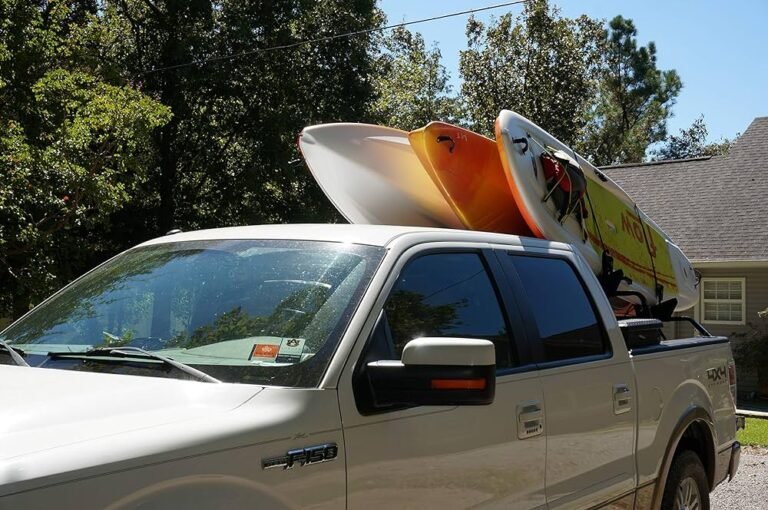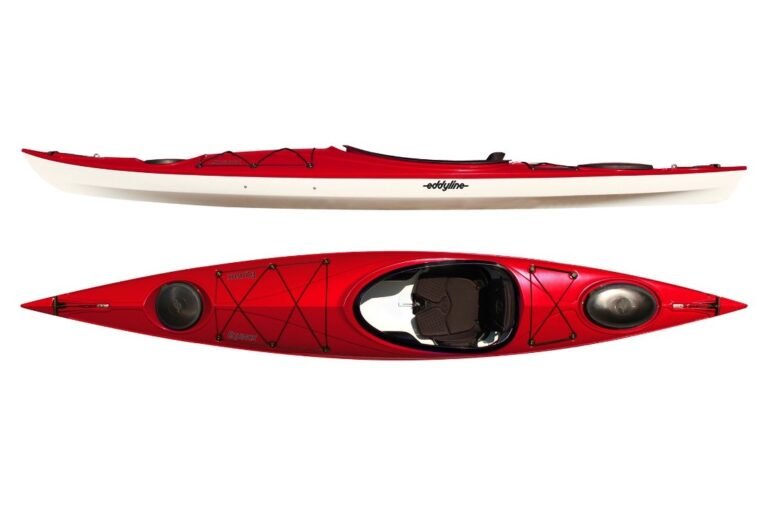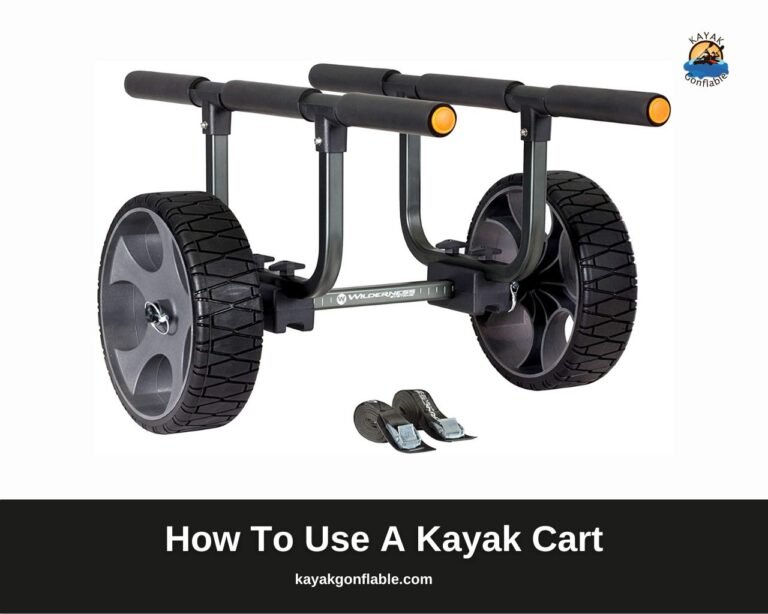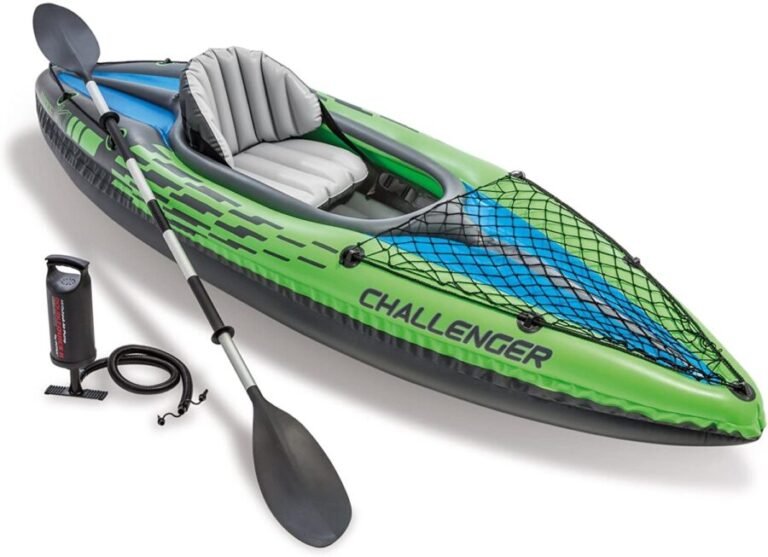What Is Kayaking: A Detailed Guide
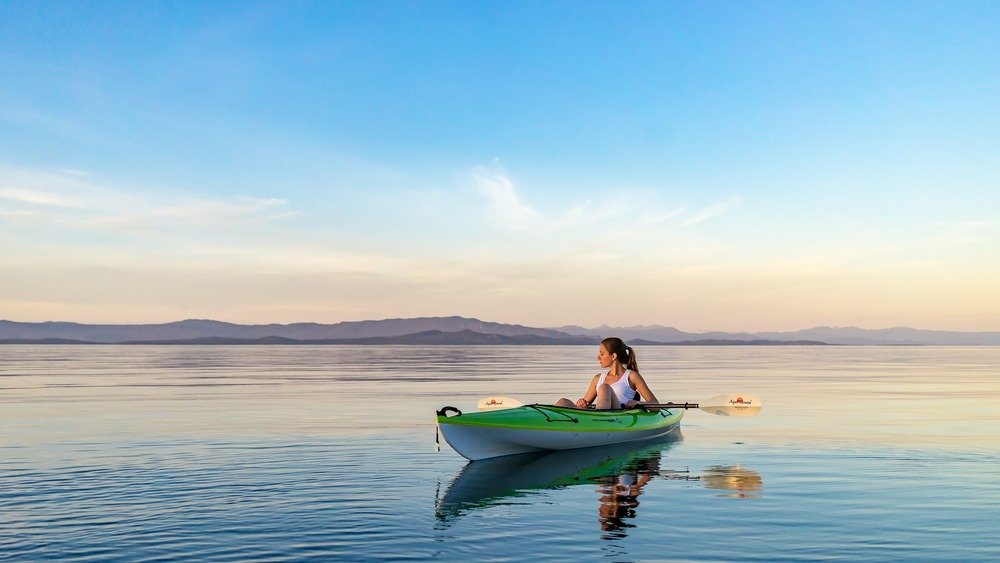
At its core, kayaking involves the use of small, narrow watercraft known as a kayak. These boats are designed for one or more kayakers to navigate through various water bodies, primarily using a double-bladed paddle.
Kayaks come in a range of different designs and sizes, each tailored to specific activities and water conditions.
Whether it’s a sleek sea kayak for long-distance kayaking or a sturdy whitewater kayak for navigating rapids and strong waterways, the core of kayaking lies in the fun interaction that occurs between the paddler, the kayak, and the water.
Health Benefits of Kayaking
Kayaking offers quite a lot of health benefits for both your body and mind. Below are some of the key benefits of kayaking:
Mental Well-Being
- Sense of Achievement: Completing a kayaking adventure or mastering a challenging river can boost your self-esteem and sense of achievement.
- Solace While On The Water: Many people find solace and rejuvenation in the water. Kayaking fosters a deep connection to the aquatic environment.
Stress Reduction
- Nature Therapy: Being on the water in a kayak provides an opportunity for nature therapy, reducing stress levels and promoting relaxation. This gives room for you to spend some time away from the hustle and bustle of your regular life.
- Mindfulness: Kayaking encourages mindfulness as you focus on the rhythm of your strokes, the sound of the water, and the beauty of your surroundings, promoting mental clarity.
- Stress Relief: Physical activity and exposure to nature release endorphins, which are natural stress relievers, leading to a sense of well-being.
Cardiovascular Health & Fitness
- Aerobic Exercise: Kayaking is an excellent cardiovascular workout. Paddling vigorously increases your heart rate, improving your overall cardiovascular health and stamina.
- Strength Builder: Kayaking engages your various muscle groups, including the shoulders, back, core, and arms, helping to build and tone your muscles.
- Low-Impact: Unlike high-impact activities, kayaking is gentle on the joints, making it accessible to people of different fitness levels and ages.
- Calorie Burning: Kayaking can help with weight loss, as it burns calories. An hour of kayaking can burn anywhere from 300 to 500 calories, depending on your intensity.
Connecting With Mother Nature
- Environmental Awareness: Kayakers often develop a heightened awareness of environmental issues and the importance of preserving natural waterways.
- Adventure and Exploration: Exploring new waterways and discovering hidden coves and landscapes can be a source of adventure and excitement.
- Calmness: The tranquility of being on the water can provide a sense of calm and escape from the stresses of modern life.
- Wildlife Encounters: Kayaking allows you to get up close to wildlife, fostering a sense of wonder and connection to the natural world.
Types of Kayaks
Kayaking enthusiasts have a ton of options to choose from when it comes to selecting the right kayak for their activities. Each type of kayak is purpose-built, offering unique features and capabilities to suit different water conditions and activities.

Recreational Kayaks
Recreational kayaks are the go-to choice for beginners and casual paddlers. They are characterized by their wide, stable hull design, making them easy to maneuver and maintain balance in calm waters.
These kayaks typically have a large cockpit, making it simple for paddlers to enter and exit. They are often shorter in length, which aids in turning and navigating tight spaces.
Best Use Cases
- Photography and Bird watching: The stability and ease of use make recreational kayaks a popular choice among nature photographers and birdwatchers, allowing them to get close to wildlife without disturbing it.
- Leisure Kayaking: Recreational kayaks are perfect for calm lakes, slow-moving rivers, and ponds. They are ideal for relaxed outings, where the focus is on enjoying the scenery and a peaceful day on the water.

Touring Kayaks
Touring kayaks, also known as sea touring or expedition kayaks, are designed for long-distance kayaking trips on open water.
They have a longer and narrower profile compared to recreational kayaks, which enhances their speed and tracking abilities. Touring kayaks often feature multiple storage compartments for gear and supplies, enabling multi-day adventures.
Best Use Cases
- Open-Water Exploration: Touring kayaks excel in open water conditions, such as coastal kayaking and ocean expeditions. Their design allows for efficient tracking and the ability to cover long distances with ease.
- Multi-Day Trips: These kayaks are equipped to carry camping gear, making them ideal for extended trips where you can explore remote islands and coastal areas.

Whitewater Kayaks
Whitewater kayaks are built for adrenaline junkies and thrill-seekers. They come in various styles, including playboats, river runners, and creek boats.
These kayaks are short, highly maneuverable, and designed to handle the turbulent and fast-flowing waters of rivers and rapids. They have a reinforced hull to withstand impacts with rocks and obstacles.
Best Use Cases
- River Rapids and Creeks: Whitewater kayaks are tailor-made for navigating challenging river rapids and difficult creek descents, offering the agility needed to maneuver through tumultuous waters.
- Freestyle Kayaking: Playboats, a subcategory of whitewater kayaks, are designed for performing tricks and maneuvers in features like standing waves and hydraulic currents.

Sea Kayaks
Sea kayaks are built for open-water adventures, providing stability, speed, and ample storage. They have a longer profile for increased speed and tracking, along with a skeg or rudder to aid in course correction. Sea kayaks often feature a closed cockpit with a spray skirt to keep paddlers dry in rough conditions.
Best Use Cases
- Coastal Expeditions: Sea kayaks are perfect for exploring coastlines, archipelagos, and island chains. They handle rough water conditions, such as ocean swells, waves, and wind, with ease.
- Wildlife Observation: The stability and quietness of sea kayaks make them an excellent choice for observing marine life, such as whales, dolphins, and seabirds, up close.

Sit-On-Top Kayaks
Sit-on-top kayaks have an open design with a molded seat on top of the hull, rather than an enclosed cockpit. They are known for their stability, ease of entry, and self-draining design, making them popular for warm-weather paddling.
Sit-on-top kayaks are available in various lengths and styles, including recreational and fishing models. Since they lack an enclosed cockpit, the seat is positioned such that it allows the kayaker to paddle from above the water level.
An example is the Wilderness Systems Tarpon 120. Because they don’t have a liveable interior, all of the other features are mounted to the kayak’s deck, except for the reel.

Sit-In Kayaks
Sit-in kayaks have been around much longer than sit-on kayaks, going back to the early 1570s when they were primarily employed for hunting by the Inuit and Aleut peoples.
They were made of a variety of materials, ranging from animal skins and bones to wood, depending on the function and supplies available. The first kayaks were primitive designs created by the Inuit and Aleut people to go quickly across the water some 5,000 years ago.
Sit-in kayaks have a more conventional appearance and as a result, are simple to spot. As the name indicates, a sit-inside kayak has an enclosed cockpit. This positions the paddler below the water’s surface rather than above the water level as in sit-on kayaks.
History of Kayaking
To truly appreciate this water sport, we need to travel back in time to its historical origins. This watercraft has a rich heritage that spans thousands of years and was initially developed by indigenous Arctic cultures, such as the Inuit and Aleut peoples.
These resourceful individuals designed kayaks to facilitate hunting and transportation in the frigid waters of the North. Kayaks were constructed using a frame of wooden ribs, covered with animal skins, and sealed with whalebone or sinew, making them lightweight, maneuverable, and buoyant.
These early kayaks served a vital role in the survival and subsistence of these communities, enabling them to travel dangerous waters with ease. This historical connection to survival and sustenance continues to resonate in modern kayaking, where enthusiasts seek a profound connection with nature and adventure.
In this century, kayaking began to gain popularity beyond its traditional Arctic roots. It evolved from a mode of survival into a recreational and competitive sport. Today, kayaking is a global sport, enjoyed by individuals of all ages and skill levels.
Types of Kayaking
Recreational Kayaking
Recreational kayaking offers a good escape from the hustle and bustle of daily life. Paddlers embark on leisurely trips, exploring calm rivers, tranquil lakes, and coastal shorelines. This form of kayaking is perfect for nature enthusiasts.
Competitive Kayaking
Kayaking has also found its place in the world of competitive sports. Olympic disciplines like sprint kayaking and slalom kayaking showcase the skill and speed of athletes as they race against the clock and navigate a series of gates.
Whitewater Kayaking
For those seeking an adrenaline rush, whitewater kayaking beckons. This high-energy discipline involves navigating fast-moving, turbulent rivers and cascading rapids.
Sea Kayaking
Sea kayaking introduces a sense of exploration and adventure, as paddlers embark on extended journeys along coastlines and into open waters. It’s an opportunity to push one’s boundaries while connecting with the majesty of the ocean.
Kayaking Equipment and Gear
To go on a safe and enjoyable kayaking trip, selecting the right equipment and gear is important.
Factors To Consider When Choosing A Kayak
- Kayak Type: Determine the primary type of kayaking activities you’d like to do, whether it’s recreational, whitewater, sea, or competitive kayaking.
- Transportation and Storage: Consider the logistics of transporting and storing your kayak. Some kayaks are inflatable or foldable for easier movement.
- Skill Level: Your level of experience and skill should align with the kayak’s design and capabilities. Beginners should opt for stable, easy-to-maneuver kayaks.
- Size and Fit: Ensure that the kayak accommodates your body size and offers a comfortable seating position. A good fit can enhance control and reduce fatigue.
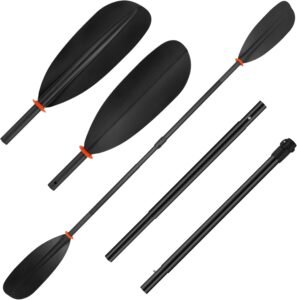
Choosing The Right Kayak Paddles
Paddles are the link between you and your kayak, and selecting the right one is crucial for efficient and comfortable paddling. Kayak paddles are specifically designed for kayaking and come in different materials, such as aluminum, fiberglass, or carbon fiber.
Kayak paddles have something called a paddle blade. Paddle blades can vary in shape, with high-angle blades providing more power and low-angle blades offering efficiency and endurance.
How to Choose the Right Paddle
- Paddle Length: The length should be appropriate for your height and the width of your kayak. Generally, a longer paddle is needed for wider kayaks.
- Paddle Material: Lightweight materials like carbon fiber offer better performance but come at a higher cost.
- Blade Shape: Select a blade shape based on your paddling style. High-angle blades are better for power strokes, while low-angle blades are ideal for relaxed paddling.
Necessary Safety Gear
Safety should always be a top priority when kayaking, and the right gear can make all the difference.

Life Jackets (PFDs)
Ensure you have a Personal Flotation Device (PFD) that fits properly and is designed for kayaking. PFDs come in various styles, including inflatable and foam-filled. Your PFD should provide adequate buoyancy and keep you afloat. It should also allow for freedom of movement.
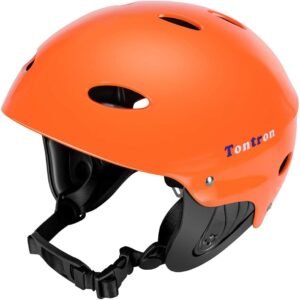
Helmets (For Whitewater Kayaking)
If you’re kayaking in whitewater conditions, a helmet is essential to protect your head from rocks and obstacles. Look for a helmet designed for water sports.
Other Safety Essentials
- First Aid Kit: Carry a compact first aid kit with essentials like bandages, antiseptic wipes, and adhesive tape.
- Safety Whistle: A whistle can be a lifesaver in emergency situations, providing a way to signal for help.
- Rescue Throw Bag: In whitewater kayaking, a throw bag with a floating rope can be used for rescue and self-rescue.
Kayak Clothing and Footwear
Appropriate Kayaking Attire
- Layering: Dress in layers, including moisture-wicking base layers, insulating mid-layers, and a waterproof outer layer to stay warm and dry.
- Sun Protection: Wear sun-protective clothing, including a wide-brimmed hat and sunglasses with UV protection.
Footwear Options
- Water Shoes: Water shoes provide grip, protection, and comfort while allowing water to drain.
- Neoprene Boots: These are excellent for cold-water kayaking, offering insulation to keep your feet warm.
Safety Precautions For Kayaking
Float Plan
- Share Your Plan: Inform someone you trust about your kayaking plans, including your destination, expected return time, and emergency contact information.
- Emergency Procedures: Familiarize yourself with self-rescue and assisted rescue techniques. Know how to re-enter your kayak if you capsize.
Weather Monitoring
- Weather Updates: Continuously monitor the weather conditions throughout your trip and be prepared to change your plans if necessary.
- Wind Awareness: Pay attention to wind patterns and their potential impact on your kayaking experience.
Your First Kayaking Trip
Launch Your Kayak
Approach the water’s edge carefully and launch your kayak. Be mindful of rocks, shallow areas, or strong currents. Maintain balance in your kayak by keeping your weight centered. Learn to paddle efficiently by using proper strokes.
Enjoy Nature
Take in the beauty of your surroundings, whether it’s a serene lake, a meandering river, or a picturesque coastal shoreline. Keep an eye out for wildlife, but remember to maintain a respectful distance to avoid disturbing animals.
Safety First
If you capsize, remain calm, and follow your self-rescue training. Your PFD will keep you afloat. If kayaking with others, stay together, communicate, and be prepared to assist each other if needed.
Return Safely
Keep track of the time and ensure you return to your starting point before it gets dark or the weather deteriorates. Follow Leave No Trace principles by packing out all trash and leaving the natural environment as you found it.
Kayaking offers not only physical fitness benefits but also mental well-being and a deep connection to nature. It provides an opportunity to explore the world from a unique perspective, creating a lasting bond with the water and the outdoors.
As you embark on your kayaking adventures, remember that every journey is an opportunity to learn, grow, and appreciate the beauty of nature. Whether you’re a novice or an experienced paddler, kayaking has something to offer everyone.

